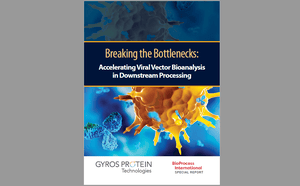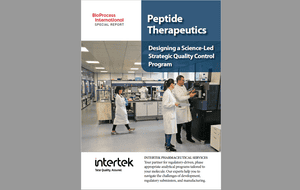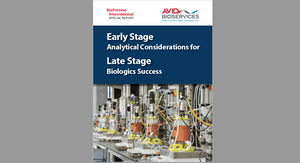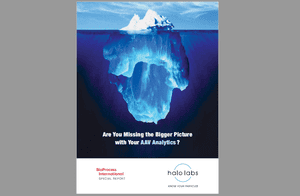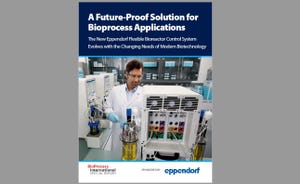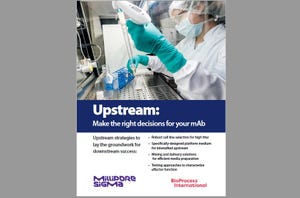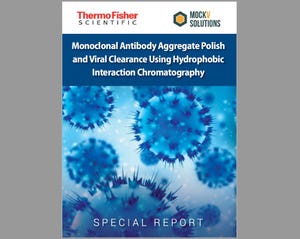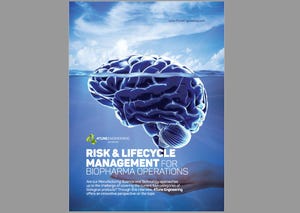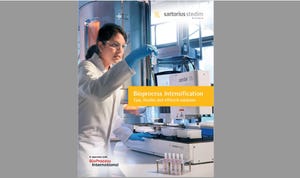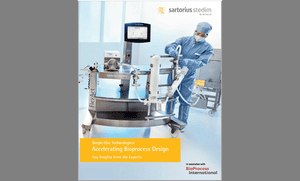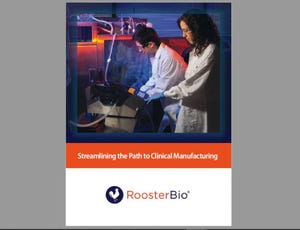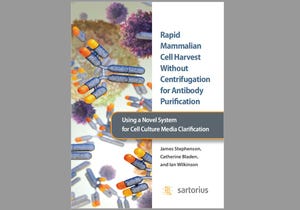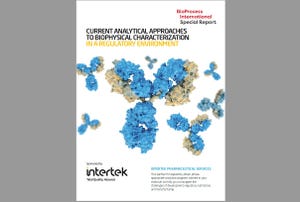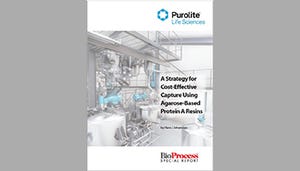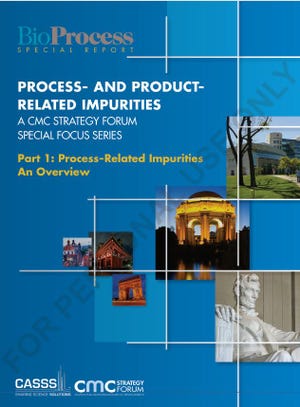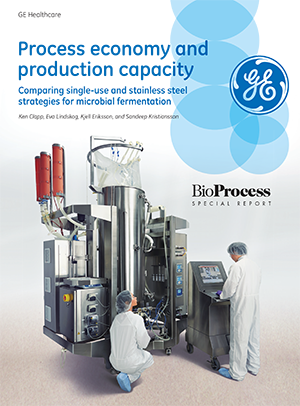Special Reports
The rise in popularity of viral-vector–based gene therapies and SARS-CoV-2 vaccines has created a shortage of manufacturing capacity, driving efficiency improvements to avoid bottlenecks in bioanalysis to support culture optimization and bioprocessing steps. To improve workflows in bioanalytical assay development and sample analysis, more efficient methods are needed that include higher throughput, simpler and more streamlined sample assay methods, wide dynamic ranges, and efficient data processing and interpretation. Gyrolab™ microfluidic, nanoliter-scale immunoassay systems provide an innovative, robust solution to high-performance bioanalysis of culture and bioprocessing samples. Gyrolab immunoassays are fully automated, utilizing a novel microfluidic, compact disk (CD)-based format with 96 microstructures each containing a flow-through affinity column for assay reagent binding and detection. Conversion of plate based enzyme-linked immunosorbent assays (ELISAs) to Gyrolab format dramatically reduces an...
Peptide therapeutics are a unique class of pharmaceuticals. They can fall into one or more regulatory categories: as conventional chemical molecules, biological entities, or biosimilars. Developing a well–thought-out quality control (QC) strategy is key to meeting development milestones and complying with evolving regulatory requirements. Safety assessment is critical because slight changes in the structure, physicochemical properties, stability, and impurity profile of a peptide can provoke an adverse immune response. A robust analytical QC program should be conducted in laboratories that comply with good manufacturing practices (GMPs) to help establish and meet specifications, supporting regulatory submissions. These programs should be tailored to a peptide of interest to ensure precision, selectivity, and confidence in the results generated. A careful selection of techniques is key. This Special Report introduces the regulatory and scientific considerations for peptide development and key analytical ap...
This BPI Special Report will cover phase appropriate analytical strategies that will balance various drivers to meet overall development goals without sacrificing the requirements of a program. The goal is to provide important recommendations for analytical method development that can help the biopharmaceutical industry identify opportunities to improve lead time and reduce development costs while maintaining required quality standards.
Fill out the form below to learn more about analytical method development now.
Arugadoss Devakumar,
PhD, is director of analytical development at Avid Bioservices, 2642 Michelle Drive #200, Tustin, CA 92780;
https://www.avidbio.com
.
Speed to market is an important consideration for the development of lifesaving therapies, including recombinant monoclonal antibodies. However, increased speed must be balanced with quality to enable quick and efficient delivery of biopharmaceuticals to patients. Important determinants of quality include the genomic location and integrity of the transgene sequence within a recombinant cell line. Traditional methods of genetic characterization can provide incomplete information and results can be difficult to interpret. However, next-generation sequencing (NGS) approaches such as Targeted Locus Amplification (TLA) techniques are proving to be powerful tools for providing information-rich analysis of transgenes and their integration sites. In this study, we describe how Cergentis’s TLA technology allows FUJIFILM Diosynth Biotechnologies to support rapid characterization of clonal cell lines during Apollo™ X cell line development and clone selection. This includes a rapid and early confirmation of recombina...
Managing risk in single-use systems design and implementation is a shared responsibility.
The ultimate responsibility for drug processes and products will always remain with manufacturers. However, implementation of single-use systems can shift responsibilities to suppliers within key areas, including design and sterilization, which must be clearly controlled and validated.
This Special Report discusses how suppliers and manufacturers when working together can mitigate the risk of applying single-use systems in biopharmaceutical production from design through validation to point-of-use testing and operator training.
Fill out the form below to read this Special Report now.
Hélène Pora,
PhD, is vice president of technical communication and regulatory strategy at
Pall
, where she leads technical training and regulatory support improvements. She has been instrumental in the development of Pall single-use technologies for the past 20 years while heavily involved in manufacturing, quality, and regulatory aspe...
This educational podcast, “The Evolution of Culture Systems for Viral Vector Production: Advantages, Challenges and Cost Considerations,” recently published by
Cell and Gene Therapy Insights
, discusses in detail the pros and cons of viral vector production in adherent and suspension cell culture.
This special report illustrates how Pall Biotech’s
iCELLis 500+ bioreactors
and
Allegro STR bioreactors
can bolster adherent and suspension culture, respectively, for viral vector production. Fill out the form below to read the complete report and learn more now.
Subvisible particle (SVP) analysis is a key indicator of stability and safety and is an essential parenteral drug quality metric. Yet assessment of SVPs is especially challenging in adenoassociated virus (AAV) vector formulations, in which limited precious sample is available. Traditional SVP methods consume large sample volumes, while dynamic light scattering (DLS), size-exclusion chromatography (SEC), and visual inspection can miss aggregates in the subvisible range entirely. This special report introduces backgrounded membrane imaging (BMI) technology as a solution for detection and quantification of subvisible viral vector aggregates in low-volume, high-throughput format. BMI is fully automated, is fluidics-free, and requires only 25μL of sample.
Fill out the form below to read the special report now
.
Computer-aided biology
describes a growing ecosystem of tools that augment human capabilities in the laboratory. In this report we give two case study examples of how computer-aided biology has transformed industrial gene therapy bioprocessing. Read on to discover how Synthace’s Antha cloud-based software platform has enabled industrial collaborators Oxford Biomedica and the Cell and Gene Therapy Catapult to harness the power of Bioprocessing 4.0 by:
Fill out the form below to learn more about the Antha platform now.
Sponsored Content
A Future-Proof Solution for Bioprocess Applications: The New Eppendorf Flexible Bioreactor Control System Evolves with the Changing Needs of Modern BiotechnologyA Future-Proof Solution for Bioprocess Applications: The New Eppendorf Flexible Bioreactor Control System Evolves with the Changing Needs of Modern Biotechnology
In the biopharmaceutical industry’s quality-by-design (QbD) era, optimizing tools for process monitoring and control has become a major focus of development and manufacturing. This increased attention brings challenges into upstream and production processes, cell-line development, process optimization, and scale-up. Suppliers of equipment and technologies also focus on helping their customers improve development timelines. With that increased attention to speed, they are offering tools such as the Eppendorf SciVario twin bioreactor control system to streamline development and maximize flexibility.
BPI spoke with Dr. Stephan Zelle and Dr. Berit Cleven about Eppendorf’s approaches to optimizing process development using their company’s SciVario twin system. Herein are their combined comments in response to our questions.
Fill out the form below to read the special report now
.
For more information about the SciVario twin bioreactor control system, visit
www.eppendorf.com/scivario
.
Stephan Zelle
Dr. rer. ...
Bioprocess decisions made during upstream operations can be difficult to reverse at later, more costly stages of biologic manufacture. They even can require significant backtracking, wasting precious time, labor, and material. Read this Special Report to learn ways to optimize monoclonal antibody bioprocessing upstream. Specifically, you will learn about
Equipped with this information, you will be able to lay the groundwork for downstream success.
Fill out the form below to read the entire report now.
The biopharmaceutical industry is in the midst of an exciting transformation as biologics experience massive growth — even outpacing the small-molecule segment (
1
). Biologics are predicted to comprise over a quarter of the pharmaceutical market in 2020 (
2
). At the same time, a plethora of new biologically derived therapy concepts — e.g., cell and gene therapies — are in development. Some biologics classes have become mainstream — e.g., monoclonal antibodies — with biosimilars entering the market and contract manufacturing organizations (CMOs) expanding their volume output. It is hard to say which of the novel and more personalized therapeutic concepts will disrupt the market in the coming years.
This BPI Special Report features a virtual roundtable discussion about developments in analytical technology toward the goal of bioprocessing 4.0. Fill out the form below to read the entire report now.
References
1
Kent D, Rickwood S, Di Biase S.
Disruption and Maturity: The Next Phase of Biologics
. Quint...
Hydrophobic Interaction chromatography (HIC) is a powerful polishing tool for the downstream purification and manufacture of biotherapeutics. HIC offers orthogonal selectivity for the clearance of difficult process and product-related impurities such as aggregates, host cell proteins and endogenous and adventitious viruses. In this study, a family of POROS HIC resins with novel ethyl and benzyl chemistries was used to successfully polish two clinical stage monoclonal antibodies harboring very high levels of product aggregation (>10%). In addition to aggregate removal, viral clearance using optimized HIC processes was also extensively studied though the use of a novel prediction technique centered on a parvovirus surrogate “Mock Virus Particle” (MVP) combined with live virus “spiking” data using xenotropic murine leukemia virus (XmuLV) and minute virus of mice (MVM). The results from these studies demonstrate the high productivity aggregate and viral clearance capability of POROS HIC chromatography resins...
By working with the best biopharmaceutical companies for over a decade, 4Tune Engineering (4TE) has built a portfolio of services that enables companies to address
current-century challenges. The biotechnology industry needs to address advanced therapies and personalized medicines and deliver explicit patient outcomes. Biologics today fall into four categories: monoclonal antibodies (MAbs), biosimilars, advanced therapeutic medicinal products (ATMPs), and cell and gene therapies (CGTs). Consequently, we can ask whether our manufacturing science and technology (MSAT) approaches are up to the challenge of covering all those different types of product.
The following Special Report details 4TE’s strategies for applying the US Food and Drug Administration’s totality-of-evidence approach for risk-based biologic development. Fill out the form below to read the full report now.
Richard Richieri, chief operation officer (COO) of Avid Bioservices, recently presented an Avid case study and strategy to design, prepare, and execute process validation in preparation for successful product approval inspections. The goals of the presentation were to share lessons about some of the strengths learned from Avid’s experience and to offer advice on industry best practices.
Finding a CMO that meets your quality expectations and scale is a key driver for your eventual commercial success. Particularly, working with CMO that also can support your material needs from early clinical to commercial phase should be considered as a major factor to ensure the success of your products.
Fill out the form below to read the full Special Report now.
To improve their bioprocess performance, life-science specialists need flexibility in their R&D laboratories because of constantly changing bioprocessing demands. In addition, more experiments need to be performed with more accuracy and reproducibility on less bench space than ever before — and with limited budgets. Therefore, having flexibility in the number of bioreactors that fit available bench space and budget is crucial — along with the flexibility to connect and integrate the right software, sampling tools, and analytical devices. Running multiple processes in parallel allows operators to optimize their microbial or cell culture process conditions quickly and to increase their productivity with less effort.
Applikon’s Matrix multibioreactor platform is a turn-key solution that combines a bioreactor, a process controller, an automated sampler, and an analyzer with data management software into a single platform that offers a uniform and easy-to-operate interface for all connected equipment.
Fill out...
Propelled by single-use systems (SUSs), biopharmaceutical companies are approaching the ideal of continuous bioprocessing. In addition to improving process integrity and decreasing production costs, SUSs have enabled exciting ways to configure, operate, and evaluate manufacturing steps. Sensitive process analytical technologies (PATs) and discriminating data analysis platforms are supplementing those developments, helping process engineers and operators to study and modify workflows in unprecedented ways. The goal now is to
intensify:
to apply increasingly nuanced process knowledge and growing technological capability in ways that simplify, condense, abbreviate, and integrate distinct processes.
But intensification is easier said than done. And considering the industry’s ambiguous uses of the term, process engineers and operators need clear instruction about how to accomplish it. The writers, speakers, and interviewees featured in this
BPI
compilation offer such guidance. These articles detail how exp...
Companies turn more and more to single-use technologies (SUTs) to mitigate production challenges — and with good reason. SUTs clearly decrease conventional costs while increasing process integrity. Yet as the writers in this compilation suggest, SUTs are now making possible new, exciting ways to configure, operate, and evaluate biomanufacturing. In this compilation,
BioProcess International
gathers key insights from biopharmaceutical industry experts at Sartorius Stedim Biotech to explore how SUTs can realize high-quality yet cost-effective end-to-end bioprocessing. The studies herein identify not only the advantages of SUTs, but also the things that companies need to ensure process success when adopting them.
Fill out the form below to read the full eBook.
Careful consideration of lot size is crucial for multiyear success of a cell therapy business. RoosterBio’s product design and acceleration business works with the company’s customers to help make plans that are appropriate for their stages of product and clinical development. We use the following major considerations in creating a sound multiyear strategy with intermediate milestones:
This special report explains how cell therapy contract services can help biotechnology startups ensure multiyear success. Just fill out the form below to read it now.
Corresponding author
Taby Ahsan,
PhD, is vice president of analytical, product, and process development, and
Jon A. Rowley,
PhD, is founder and chief product officer at RoosterBio, 5295 Westview Drive, Suite 275, Frederick, MD 21703; 301-200-5366.
Monoclonal antibody (MAb) expression systems typically use signal peptides to ensure secretion of antibodies into cell culture media. Although that reduces the complexity of purification and prevents the need for cell disruption, it does require using expensive and time-consuming techniques to separate cells from antibody-containing cell culture fluids. In this study, we describe our tests of the novel Sartoclear Dynamics Lab V system (Sartorius S Lab Instruments GmbH and Co. KG) for rapid clarification of cell culture media without requiring centrifugation or additional costly equipment. The filtration system was tested and compared with the method currently used to separate cells from antibody-containing cell culture fluids. That standard clarification method includes an initial centrifugation step followed by filtration of the cleared supernatant through a 0.45-μm filter on a vacuum-driven bottletop filter.
Further Reading
Kempken R, Preissmann A, Berthold W. Clarification of Animal Cell Cultures on a ...
Structural integrity of protein-based therapeutics is one of the major challenges in the biopharmaceutical industry. Multiple factors such as product stability, efficacy, and shelf life could be affected following minor changes in manufacturing process. Multiple biophysical methods employing spectroscopic and calorimetric tools can be used to analyse Higher Order Structure (HOS). Moreover, with an increasing demand for generating as much structural information as possible for regulatory submissions, a requirement for these analyses in a GMP environment is also important.
This report focuses on current biophysical analyses that provide a better understanding of a biologic drug and new analytical approaches that are key to a successful program addressing critical quality attributes to support regulatory submissions.
Just fill out the form below to download this Special Report now.
References
1
Kaplon H, Reichert JM. Antibodies to Watch in 2019.
MAbs
11(2) 2019: 219–238; doi: 10.1080/19420862. 2018.155646...
Upstream bioprocessing in perfusion mode holds great promise for industrial production of cells and biologics. In perfusion, fresh medium is added constantly to the bioreactor, and used medium is harvested while the cells are retained in the bioreactor. As a result, the composition of the cell culture medium stays quite constant during the process. This offers several advantages. In perfusion, higher cell densities can be reached than in batch and fed-batch processes, therefore enhancing volumetric productivity. Because medium composition can influence cell metabolism and therefore product characteristics, the more constant the process conditions, the more consistent may be the product quality. Products that pass through the cell retention device are constantly harvested. The time they reside in the culture medium is reduced from that of a fed-batch culture, which is advantageous for production of less-stable products.
Apart from being used for production of secreted proteins or viral vectors, perfusion m...
Special Report on Process- and Product-Related Impurities (A CMC Strategy Forum Special Focus Series): Extractables, Leachables, Particles, and AggregatesSpecial Report on Process- and Product-Related Impurities (A CMC Strategy Forum Special Focus Series): Extractables, Leachables, Particles, and Aggregates
Introduction
Accelerate activity. Improve predictability. Drive higher process efficiency. Increase quality. Lower cost of goods sold (CoGS). Secure supply. In an era where the biomanufacturing wheels turn faster by the day, where the stakes are higher and the choices seemingly endless, it is easy to become overwhelmed. How can you make good biomanufacturing decisions and develop robust long-term strategies when the environment is constantly changing? Whether a political shift affects your product or market, a natural disaster disrupts your supply chain, or some other external influence suddenly alters your plan, you have needs that must be met and people counting on you to deliver product. In such situations, extensive bioprocessing knowledge and experience are invaluable tools that will make a difference. Good insights about technical advancements, process economy implications, and sustainability aspects can help improve your individual decisions and increase the likelihood of success.
Recently, four re...
Emily Shacter, PhD,
Consultant
, ThinkFDA LLC
Email Emily
This is a transcript from a Q&A interview with Emily Shacter, PhD, Consultant, ThinkFDA LLC (former FDA Scientist and Regulator).
We will be talking today about the CMC Forum that was published back in 2005. We are revisiting it in the magazine to specifically update our understanding of how to maintain process control; understanding your process.
In general, how do you feel the discussions in the four-part paper from 2005 has held up after 10 years?
Emily: I think they have held up well. We spent many years developing principles through which to regulate protein products so what we discussed back in 2005 was all very well considered. Companies have also spent decades figuring out how to manufacture and control protein products. By the time we got to the 2005 forum where we talked about control of process- and product-related impurities, the field had already come a long way. There are certain details that have changed over the past decade – and w...
Introduction by Cheryl Scott
The CMC Strategy Forums focus on relevant chemistry, manufacturing, and controls (CMC) issues throughout the life cycle of a therapeutic and thereby foster collaborative technical and regulatory interaction. Forum chairs share information with regulatory agencies to help them merge good scientific and regulatory practices. Outcomes of forum meetings are published in BioProcess International and on the CASSS website (www.casss.org). This process is meant to help ensure that biopharmaceutical products manufactured with advancing technologies in a regulated environment will continue to be safe and efficacious.
This new special report series highlights a major subject area that has been covered over the first 10 years of the CMC Strategy Forum series: process-and product-related impurities. Appearing quarterly throughout 2016, these inserts will reprint four original articles along with updated discussions of their subject matter. We begin this month with a general overview of pro...
In recent years, single-use technology has been migrating into many unit operations. With the commercial availability of such systems end users have a new option for process development and production that does not rely on operational complexities and utility requirements of conventional sterilize-in-place (SIP) or autoclavable systems.
However, just as for cell culture processes, single-use technology may not apply to each and every fermentation or microbial process. It is the responsibility of practitioners to properly assess their own applications, select appropriate technology, and manage its implementation.
GE Healthcare has compared production capacity and process economy between stainless steel and single-use equipment in microbial processes and presents its study results in this free ebook download.
Special Report on Assays, Test Methods, and Comparability The CMC Strategy Forum Series, Part 4, The Role of Higher-Order Structure in Defining Biopharmaceutical QualitySpecial Report on Assays, Test Methods, and Comparability The CMC Strategy Forum Series, Part 4, The Role of Higher-Order Structure in Defining Biopharmaceutical Quality
Cosponsored by CASSS (an International Separation Science Society) and the US FDA, the 17th CMC Strategy Forum was designed to explore the relationships between higher-order molecular structure and quality of therapeutic proteins and peptides, vaccines, and blood-derived products. Understanding those relationships is important to defining and controlling the critical quality attributes (CQAs) of biopharmaceutical products. The forum program highlighted the current state of the art for analytical tools used to monitor higher-order structure. Case studies demonstrating the effects of changes to higher-order structure on biological function illustrated approaches to defining correlations. Presentations by experts from regulatory agencies, academia, and industry were followed by discussions focused on correlating data derived from analytical tools to biological functions of molecules.
Regulatory Perspectives
Proteins are complex, three-dimensional (3D) structures capable of considerably changing their conform...
